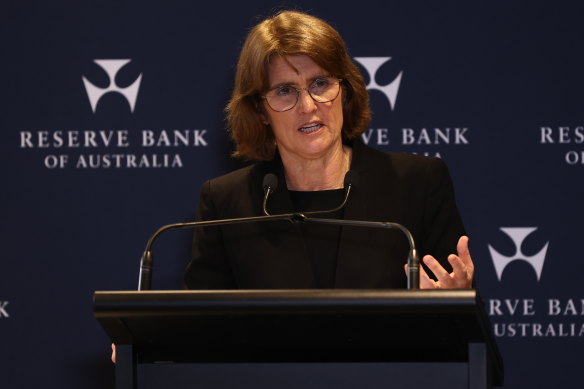‘Not what people want to hear’: RBA holds rates steady, douses hope of pre-Christmas cut
By Shane Wright and Millie Muroi
Reserve Bank governor Michele Bullock has sought to kill off hopes of a pre-Christmas interest rate cut despite forecasting a sharp fall in headline inflation over coming months and an economy slowdown perilously close to a recession.
Following the bank board’s latest two-day meeting at which it held the official cash rate at 4.35 per cent, Bullock used a press conference to pour cold water on financial market expectations of a rate reduction at the RBA’s December meeting or even earlier.

Reserve Bank governor Michele Bullock on Tuesday.Credit: Dominic Lorrimer
Despite the bank now expecting economic growth to slow to just 0.9 per cent over the 12 months to June, revising down its forecasts for wage growth and tipping inflation to fall to 2.8 per cent by the middle of next year, Bullock said predictions of “near-term” rate cuts were overblown.
“So based on what I know today and what the board knows today, what we can say is that a near-term reduction in the cash rate doesn’t align with the board’s current thinking,” she said.
“I understand that this is not what people want to hear. I know there are many households and small businesses that are struggling with interest rates where they are.
“But really the best thing we can do, and I’ve said this before, the best thing we can do is to bring inflation back down to target because we can’t let inflation get away.”
While headline inflation is expected to ease back within the RBA’s 2-3 per cent target by early next year, the first time it will have been there since the start of 2020, underlying inflation is not expected to fall to the target band until Christmas 2025.
Bullock said if underlying inflation was not falling sufficiently quickly by the middle of next year, then the bank would have to make “some very difficult decisions”.
Price pressures will ease over coming months because of federal and state government subsidies, including those for energy and public transport. But inflation will jump again when those subsidies end in the second half of 2025.
Treasurer Jim Chalmers described the Reserve Bank’s decision to leave official interest rates on hold as one that would be welcomed by people under cost-of-living pressures.
Speaking in Brisbane, the treasurer said the expected fall in inflation would be a boost to Australians.
“Another important point from the RBA’s statement today is that it forecasts that headline inflation is expected to dip below 3 per cent in the next year due to the government’s cost-of-living measures,” he said.
Shadow treasurer Angus Taylor accused the federal and state governments of adding to demand across the economy and putting upward pressure on inflation.
“There is an alternative way forward. And that’s getting back to basics. That means making sure the economy is growing faster than you’re spending,” he said.
The bank, which released its quarterly outlook on the economy, noted growing uncertainties including that inflation in the services sector remained persistent and that high unit labour costs were an ongoing issue.
In May, the RBA forecast government spending would grow by 1.5 per cent this year. It is now expecting it to surge by 4.3 per cent.
It is forecasting a lift in household spending back to its pre-pandemic average by mid-2025, as the stage 3 tax cuts and slowing inflation support real household incomes, and as the country’s population continues to grow.
“Wages growth appears to have peaked but is still above the level that can be sustained given trend productivity growth,” it said.
“On the other hand, momentum in economic activity has been weak, as evidenced by slow growth in GDP, a rise in the unemployment rate and reports that many businesses are under pressure.”
That softness in the jobs market was evident in the latest ANZ-Indeed measure of job advertisements which fell another 3 per cent in July.
ANZ economist Madeline Dunk said it was the sixth consecutive monthly decline in the measure, which is now down 16.7 per cent since January. Over the past 12 months, ads have fallen by almost 21 per cent.
The Commonwealth Bank’s head of Australian economics, Gareth Aird, believes the RBA will have to cut interest rates before Christmas, saying a reduction could come at its November meeting.
He said inflation is likely to be lower than forecast by the RBA while unemployment will be higher.
“Recent events offshore, particularly in the US, highlight that the picture can change quite quickly if the data makes the case. And history shows that central banks can turn on a dime if outcomes deviate from their expectations (in either direction),” he said.
But other economists are not convinced of pre-Christmas relief for home buyers.
Oxford Economics Australia head of macroeconomics forecasting, Sean Langcake, said people should be prepared for interest rates to stay elevated.
“We think the economy is now out of the ‘danger zone’ where further rate hikes were possible. But, households will need to be patient in waiting for interest-rate relief,” he said.
“The economy is slowing, but spare capacity is scarce. We do not expect the first rate cut to come until early 2025.”
Cut through the noise of federal politics with news, views and expert analysis. Subscribers can sign up to our weekly Inside Politics newsletter.